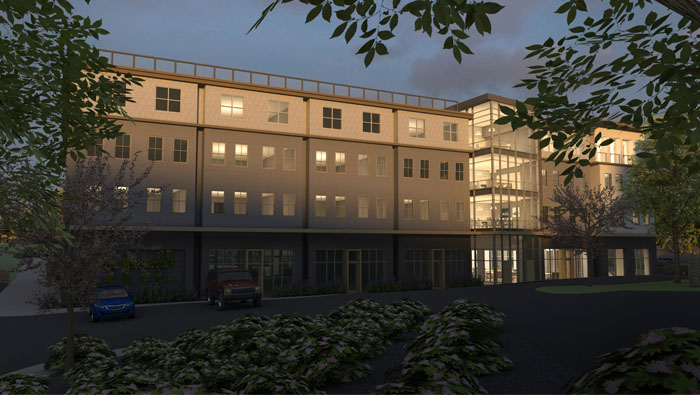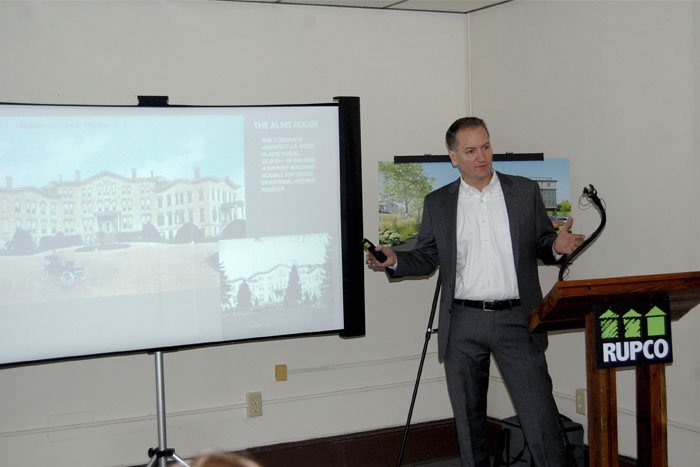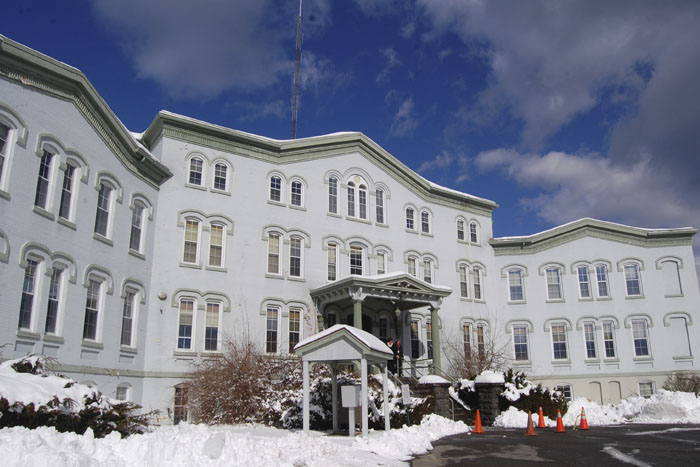
A rendering of the to-be-built senior housing on the campus. (RUPCO)
A proposal to create 66 units of low-income supported housing at a historic site on Flatbush Avenue will have its first public hearing next week.
Project sponsors RUPCO say that the proposed “Landmark Place” at the site of the former Kingston Almshouse will fill a desperate need for affordable supported housing for the elderly, disabled and recently homeless. But opponents of the proposal argue that the property could have been put to more profitable use, and neighbors speaking at recent city planning board meetings have expressed concerns the project will decrease their homes’ values.
A public hearing for the Landmark Place proposal before the city planning board is set for Tuesday, Feb. 28 at 6 p.m. in the Common Council chambers at City Hall, 420 Broadway. RUPCO is seeking a zoning change (the area is currently zoned for single-family homes). The zoning change also needs approval from the Kingston Common Council. If it’s approved, the housing nonprofit can apply for the site’s inclusion in the state and national register of historic places — a designation that will clear the way for tax credits to help fund the project. The planning board has signed off on a zoning change but in its resolution of support stated the exact nature of that change should be determined by the Common Council.
The three-story Italianate-style building at 300 Flatbush Ave. was built by the City of Kingston in 1872 to provide accommodations for the poor and elderly. Later it became a county-run infirmary and offices for the county Department of Health. In 2014, the county transferred the property to the Ulster County Economic Development Agency for sale or redevelopment. Last year, RUPCO purchased the site for $950,000.
The housing nonprofit plans to transform the property into a campus-like setting that will accommodate 66 units of supported housing for vulnerable populations including the frail elderly, people with mental health and substance abuse disorders, the disabled and the recently homeless. RUPCO Executive Director Kevin O’Connor said that he was spurred to undertake the project several years ago while touring local boarding houses which, along with motel rooms paid for by the county Department of Social Services, are the primary sources of shelter for those populations.
O’Connor described mentally ill residents crammed three or four into small rooms in dirty facilities contaminated with mold, lead paint and bedbugs. By contrast, the proposed landmark place would offer permanent housing with on-site services including security, an LPN and other support services.
“This is not a homeless shelter, this is not transitional housing,” said O’Connor. “This is permanent rental housing.”

Architect Scott Dutton discusses the project. (photo by Dan Barton)
O’Connor said Landmark Place was a small piece of a much larger effort to fund supported housing for populations that typically end up in homeless shelters or other temporary housing or on the street. Under the Empire State Supportive Housing Initiative Gov. Andrew Cuomo has proposed building 20,000 units of supportive housing statewide over the next 15 years. In September, RUPCO was one of 84 agencies that received conditional approval for funding under that initiative to develop the first 1,200 units of housing under the program. O’Connor described the ESSHI funding as a “rich pot” of state tax dollars to provide services to residents of the new supported housing units. He argued that by taking area residents who currently live in county-supported motels and other temporary housing arrangements and providing permanent housing in a state-supported residence, local taxpayers would save thousands.
“We like to bring that money here where we’re working,” said O’Connor. “Otherwise it’s going to Binghamton or Wyoming [County].”
Rebecca Sauer of the New York State Supported Housing Network said there was a desperate need for projects like Landmark Place statewide. Sauer said that the units served a subset of the homeless population that needs more than a new job or a security deposit on an apartment to live independently. Without secure housing and on-site support services, Sauer said, many end up if more expensive and less humane custodial settings.
“It’s really for people who have long term barriers to independent living be it mental health or addiction issues,” said Sauer. “[Without supportive housing] they end up in shelters, in psychiatric institutions and sometimes in jails and prisons.”
RUPCO’s proposal calls for transforming the former alms house into 35 studio and one-bedroom apartments. The renovation would also create community spaces for residents and office space for nursing staff and other support workers. The plan also calls for construction of a new building adjacent to the alms house that would contain another 32 studio and one-bedroom apartments. The new building would be restricted to residents aged 55 and older. Project architect Scott Dutton said that the ground would be augmented with new plantings, walkways and lighting to create a park-like setting for residents and visitors. Dutton added that the renovation and new construction would be guided by “evidence-based” design principles with features like natural light-filled stairwells and community spaces that have been shown to benefit physical and mental health.
“It’s a healthy, happy active design that responds to [residents’] needs and helps lift people up,” said Dutton.

The old alms house. (photo by Dan Barton)
Support not unanimous
RUPCO officials acknowledged that they have faced “pushback” on the proposal. Last year, an Ulster County lawmakers representing Kingston questioned whether the county had done enough to market the property to private investors. Legislator Dave Donaldson (D-Kingston) pointed to bids that were received after RUPCO agreed to buy the building that would have resulted in a larger payment to the county upfront and potentially more in tax revenue down the line.
RUPCO officials are negotiating a payment in lieu of taxes agreement (PILOT) with the county that is expected to amount to about $60,000 annually. The agreement will put the property on the tax rolls for the first time in its history, but will be well below what a private sector investor without a PILOT would pay.
Alderman Tony Davis (D-Ward 6) who represents the area around the alms house, said this week neighborhood residents were concerned about the impacts of the RUPCO plan on a quiet neighborhood of single-family homes. Davis said that concerns ranged from the project’s impact on property values to whether the area’s aging sewer system could handle the increased population. Davis said he had also heard from people across the city who complained that there were not enough housing options for middle-income retirees.
“I’ve spoken to my constituents and the majority are not in favor of it,” said Davis. “And they will be at the hearing to express their opinion.”
RUPCO Vice President of Real Estate Joe Eriole compared the local resistance to the project to similar concerns voiced during the agency’s long, contentious and ultimately successful effort to build low-income housing in Woodstock. Eriole said that, like the Woodstock project, he believed the impacts from Landmark place would be minimal.
“I know there are concerns now,” said Eriole. “But one year after it’s built, you’re not going to hear anything about it in any negative sense.”

Well, the question is what is the/a viable alternative for the property? The county moved out of there and now it has been vacant for quite some time. It ought be about making the best of a situation, but of course, brace for the usual floodgates of the NIMBY’s, who will appear in droves in opposition, carrying pipe dreams with them that’ll NEVER materialize for Kingston. Let the opposition fly in Donald Trump to announce he’ll drop a couple million on developing it into a “Mar-A-Lago North Hotel and Resort,” replete with mini-golf(or ANY alternative idea WHATSOEVER) Likely to happen? Ever? How about getting REAL, for a change, Kingston? (like I’ll LIVE to see the day) All these NIMBY’s appearing never make any sense;look at the redevelopment of a property on South Sterling St. for TV and Movie industry as well as other small industries–where IS the great opposition to this? Oh–won’t this “disrupt neighborhood life”(and much moreso than the planned redevelopment of the old Infirmary/Alms House/County Health Dept. offices? Ans.–Yes(and obviously so). So where is the opposition to THAT? No, folks have to focus on opposing other things but are never FOR anything–either as an alternative or a primary purpose–devoid of ideas of any kind, but nevertheless knowing exactly what they are AGAINST.
So the point is all this drama is all PSYCHOLOGICAL BALONEY without any substance at all. So I urge Alderman Davis to support this redevelopment plan despite the usual idiocy surrounding any change at all in Kingston which brings the NIMBY’s even when it is not their neighborhood out to holler about it. It’s credible, it has financing from an agency that has some money-and what, pray tell, is a good alternative? The opposition HAS NO ALTERNATIVE. Just naysayers. Baloney!!!
Best, most informative article yet on project. No other mentioned ” mental health and SUBSTANCE ABUSE DISORDERS ” -a big concern for the neighbors. Know the need for help,
but in a residential area? Will the clients be allowed to walk the neighborhood?
Did any of you bother to go to the open house that RUPCO held to find out about the project on February 19th? Did you, Marie Mercier? This is an excellent project and only part of it will house people in need of supportive housing, the rest will be developed as affordable rental housing for seniors. Instead of claiming that the future occupants have mental health and substance abuse disorders, go and find out more about supportive housing. There are many people who cannot afford housing or lose their housing because of a healthcare crisis and many homeless people have very low paying jobs and cannot the high rents that people are often charging for apartments. Landmark Place addresses these issues and at the same time saves historical landmark building by repurposing them into viable use. The Lace Mill Factory housing for artists is an excellent example of the high quality work that RUPCO does in Ulster County. No one is going to put a “boutique hotel” at that location which is really a cross-roads neighborhood with a lot of commercial properties located across a main street from a residential resident.
Susan, amazing you could answer that but when we emailed RUPCO with those substance abuse concerns we got the “Great points, we’ll have to get back to you on that” response. Maybe they should let you speak? It says right on their website only half will be used for seniors. The other half is a mixture, with no set percentage of # of vets, mental health, or substance abuse, so trying to pretend you know how many substance abuse/low income/mentally ill, etc will be there isn’t worth your time. The fact that any number of substance abuse users will be housed there should be alarming for those in close vicinity. Having them wandering the streets looking for what cars are unlocked or houses to break into to rob to get their fix doesn’t sound like my ideal life I chose when moving here to Kingston. Instead of pretending you know the future, maybe just stand in the middle and look at the real concerns from both sides.
Steve, if you bothered to go to the open house, you would have learned that 34 studio apartments in the support housing building (Kinston Alms Building), and 32 one-bedroom apartments in the new senior housing facility. There is no homeless shelter on site. Until the applicants are screened, RUPCO would not know the answer to your question about substance abusers. Stop throwing bombs at a good project. I don’t know the the future, but I do know that RUPCO carefully screens its tenants and lives up to its promises.